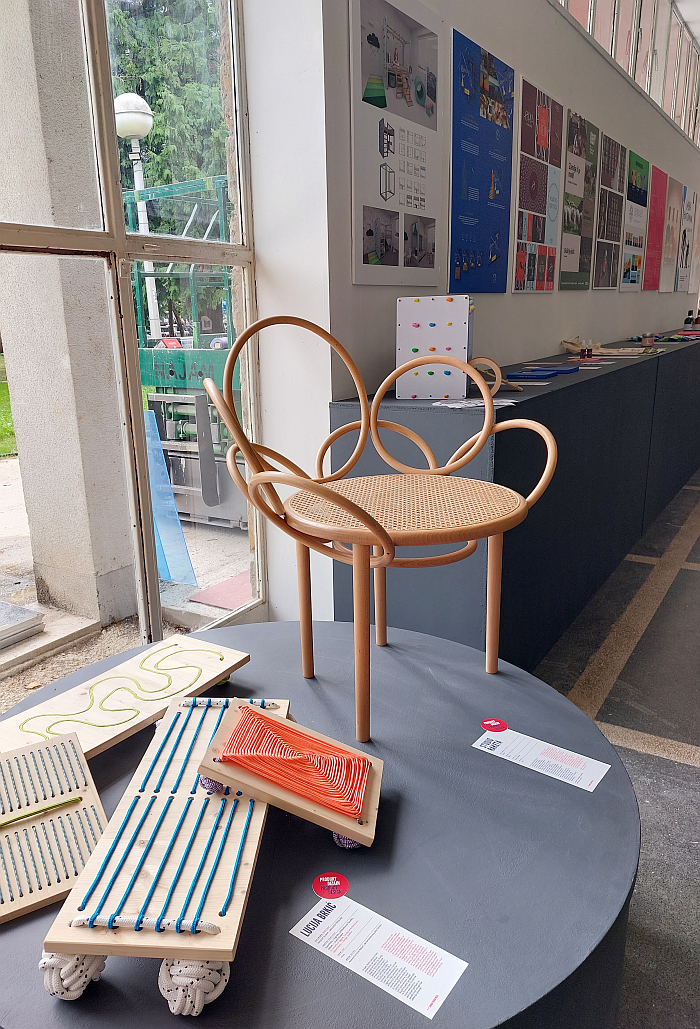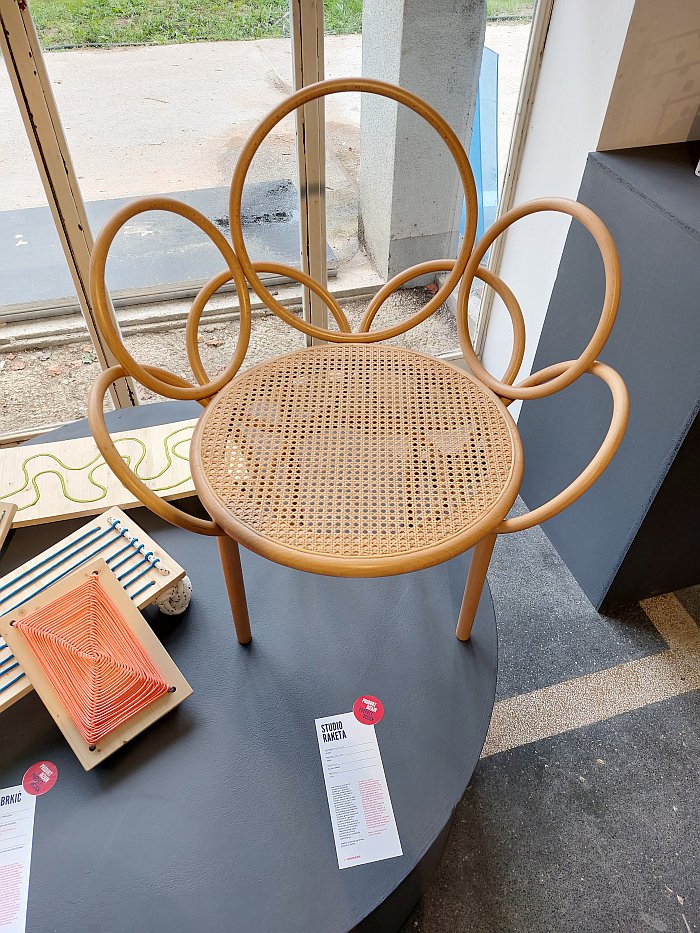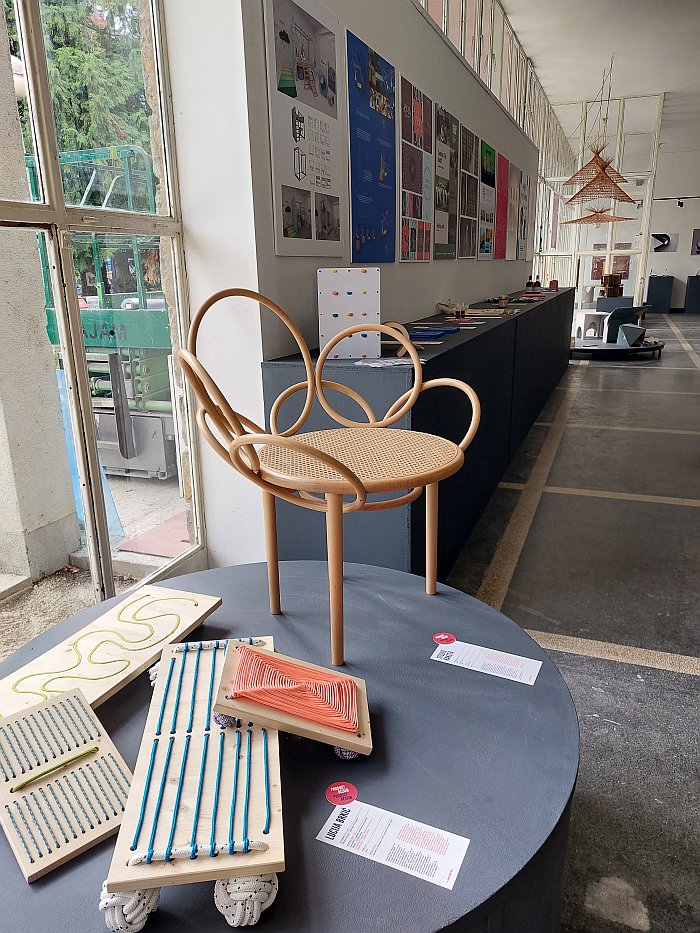
In context of critical reflections on the Bauhauses, reflections also intended to draw a distinction between the Bauhauses and the HfG Ulm, to explain that the HfG Ulm wasn't simply a post 1939-45 War continuation of the Bauhauses, Otl Aicher once asked, "is design an applied art, does it appear in the elements square, triangle and circle, or is it a discipline that draws its criteria from the task, from use, from production and technology?"1 For Aicher the answer, and the practice at the HfG Ulm, was the latter. For Aicher the practice at Bauhaus the former.
And for and at Ljubljana based practice Studio Raketa a.k.a. architects Katjuša Kranjc and Rok Kuhar?
¿Shall we ask them? ¿Or shall we try to deduce an answer from their chair Olimp as seen at Zagreb Design Week 2024?
Your right, lets try to deduce.
Developed by Katjuša and Rok for their furniture label Pikka, Olimp is, as you appreciate the name implies after viewing it, a number of (almost but not) interconnected rings which, rather than producing a megalomanic organisation that has lost all interest in what it could be in order to remain what it is, produces a most charming and engaging chair.
A chair that owes more than a passing nod to not only the geometry fixation of the 1920s and 30s but also to the geometry fixation of the 1970s and 80s, that reimagining, reformulating, of the use of geometry that was a fundamental aspect of the reimagining and reformulating of the positions and tenets of Functionalist Modernism post-1968; positions and tenets the HfG Ulm sadly never experienced, and of which Otl Aicher didn't approve.
A chair that owes more than a passing nod to the bentwood designs of a Michael Thonet, and certainly to the ca. 1900 Thonet Design Team's Chair 209/210; that chair, that composition of circles and arcs, very much admired by Le Corbusier, an architect whose works may not obviously involve circles but for whom the arc was an important component of his appreciations of, and approach, to proportions.
A chair that owes more than a passing nod to Verner Panton's 1990s Vipp rocking chair through PP Møbler, a composition of four circles (plus a couple of plastic wedges); and to Panton's 1980s Rondo chair, a composition of circles that represents a straightening up of Poul Henningsen's Snake Chair; and to Panton's 1970s Sitting Wheel, a circle in which one sat, lounged, slouched; and to Panton's 1960s Panto-Pop lounge chair, a plastic circle within which one sat; and to Panton's 1950s Peacock chair, a metal wire circle in which one sat on the ground or which could be placed atop another metal wire circle to create a lounge chair. Amongst a great many other circular works by Verner Panton. Verner Panton, in contrast to Le Corbusier, was big on circles.
As are Katjuša Kranjc and Rok Kuhar. The Pikka portfolio's defining feature is circles, as is the pairs product design portfolio. Circles that serve not just as seats but, for example, as storage space, hooks, umbrella stands or urns. A use of circles which one gets the impression is set deep in Katjuša and Rok's approach, is an important fundament of their approach to and position on design.
And thus circles which tend to align Studio Raketa more with the Bauhauses than the HfG Ulm, according to Otl Aicher's argumentation.
However, does Olimp not also arise "from the task, from use, from production and technology"?
In terms of the lattermost two, we can make no statement from the purely visual study of it enabled by its presence at Zagreb Design Week 2024; save to note that if Olimp is constructed from circles of a limited number of repeating diameters, you have a very efficient, rational, production process, which, yes, would also bring us back to Thonet. And although we sadly didn't have a measuring tape with us in Zagreb, a childish error on our part, that certainly appeared to be the case. And seeing as how Katjuša and Rok are architects, you've got to assume they have at least considered, and when applicable, employed, such an approach.
In terms of the foremost two, although we couldn't sit on Olimp in Zagreb we see no reason to doubt the ability of the wicker seat to perform its task with aplomb, nor to doubt that, again as architects, Katjuša and Rok haven't ensured an appropriate load bearing capacity for the somewhat improbably constructed backrest/siderest/armrest. And while, yes, the openness of the outermost circles, and the general improbability of the construction, does at first appear to create an insurmountable challenge in terms of using Olimp, the backrest/siderest/armrest appears to be missing, implied more than present, on the one hand that is one of the aspects the bequeaths Olimp its very pleasing aesthetic and character, one of those aspects that defines Olimp, makes Olimp the visual delight it is, enables Olimp to confidently stand in any space; on the other hand the vastness of space created by the obtuse angling of the outermost circles means that you are not limited in how you use it, how you sit on it, how you interact with it: you decide, the chair doesn't dictate as they so often do, Katjuša and Rok have left sufficient physical and conceptual space for you to decide how to use Olimp. And on the rare, and thus all the more valuable third hand, pack it full of cushions and you've got the bentwood lounge chair you didn't know was a thing. And arguably wasn't. But now it is, you realise you need. A need you didn't know you had because the solution wasn't there.
And thus means Olimp is very much a chair that exists in context of its task and use (and (potentially) production and technology). And which tends to align Studio Raketa more with the HfG Ulm than the Bauhauses, according to Otl Aicher's argumentation.
Tends to align Olimp with the two contradictory, mutually exclusive, sides of Aicher's argument.
Or to paraphrase Otl Aicher, "Olimp is an applied art, that appears in the elements square, triangle and circle, and a chair that draws its criteria from the task, from use, (from production and technology)"
¿Can it be both?
¿Can design be both?
¿Is design both?
¿Is design only both?
¿Is design either?
¿What is design?
¿Is design what Otl Aicher says it is?
¿Is design what Verner Panton says it is?
¿Is design what Le Corbusier says it is?
¿Is design what Michael Thonet says it is?
¿Is design what 1920s and 30s Functionalist Modernists say it is?
¿Is design what 1970s and 80s reformulators of Functionalist Modernism say it is?
¿Is design what Bauhaus says it is?
¿Is design what Charles Eames, Verner Panton, Roger Tallon, Joe Colombo and Fritz Eichler say it is?
¿Is design what Studio Raketa says it is?
¿What is design?
A question for us all, for each and everyone of us, a question Olimp doesn't directly answer but does provide a very pleasing framework via which to approach an answer. And, very possibly, a very pleasing space to occupy while making that approach. Not least when packed full with your favourite cushions. Round or otherwise.
More information on Studio Raketa can be found at https://raketa.si
More Information on Pikka can be found at www.pikka.si
Zagreb Design Week 2024 has now ended, more details on the event can be found at https://zagrebdesignweek.com


1Otl Aicher, Bauhaus und Ulm, in Otl Aicher, Die Welt als Entwurf, Ernst & Sohn, Berlin, 2015, page 90